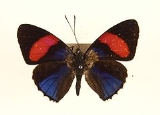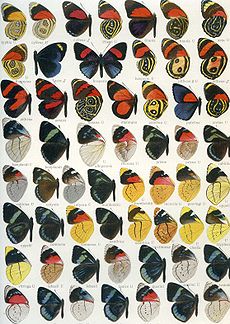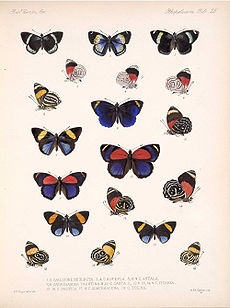
Catagramma
Encyclopedia


Genus
In biology, a genus is a low-level taxonomic rank used in the biological classification of living and fossil organisms, which is an example of definition by genus and differentia...
of Neotropical butterflies; the name continues to be used e.g. among butterfly collectors as a form taxon
Form taxon
Form classification is the classification of organisms based on their morphology, which does not necessarily reflect their biological relationships...
. "Catagramma" species
Species
In biology, a species is one of the basic units of biological classification and a taxonomic rank. A species is often defined as a group of organisms capable of interbreeding and producing fertile offspring. While in many cases this definition is adequate, more precise or differing measures are...
are popularly known as "88s", in reference to a pattern on the hindwing undersides of many that looks like the number 88. They are medium-sized (around 5 cm/2 in wingspan) forest insects.
The genus once contained over 100 species, essentially being a "wastebin taxon
Wastebin taxon
Wastebasket taxon is a term used in some taxonomic circles to refer to a taxon that has the sole purpose of classifying organisms that do not fit anywhere else. They are typically defined by their lack of one or more distinct character states or by their not belonging to one or more other taxa...
" for what was then already recognized of the clade
Clade
A clade is a group consisting of a species and all its descendants. In the terms of biological systematics, a clade is a single "branch" on the "tree of life". The idea that such a "natural group" of organisms should be grouped together and given a taxonomic name is central to biological...
that became the tribe
Tribe (biology)
In biology, a tribe is a taxonomic rank between family and genus. It is sometimes subdivided into subtribes.Some examples include the tribes: Canini, Acalypheae, Hominini, Bombini, and Antidesmeae.-See also:* Biological classification* Rank...
Callicorini in 1952. The members of "Catagramma" are nowadays divided among the related genera Callicore
Callicore
Callicore is a genus of nymphalid butterfly found in the Neotropical Ecozone. This genus, like some related ones, was formerly lumped together as the paraphyletic "Catagramma" assemblage....
, Catacore, Diaethria
Diaethria
Diaethria is a brush-footed butterfly genus found in the Neotropical Ecozone, ranging from Mexico to Paraguay.Species in this genus are commonly called eighty-eights like the related genera Callicore and Perisama, in reference to the characteristic patterns on the hindwing undersides of many...
, Paulogramma and Perisama; others (like Cyclogramma) are not often considered distinct anymore however. These genera have been found to be close relatives of Antigonis and Haematera, which like them are in the Callicorini.
J.B.A.D de Boisduval lumped
Lumpers and splitters
Lumping and splitting refers to a well-known problem in any discipline which has to place individual examples into rigorously defined categories. The lumper/splitter problem occurs when there is the need to create classifications and assign examples to them, for example schools of literature,...
this consipicuous group of Callicorini during his epic Lepidoptera reviews of the in the 1830-1850s. He ignored the generic names of previous authors, creating numerous junior subjective synonyms throughout, but was widely followed by subsequent sources. Frederick DuCane Godman
Frederick DuCane Godman
Frederick DuCane Godman D.C.L., F.R.S., F.L.S., F.G.S., F.R.G.S., F.E.S., F.Z.S., M.R.I., F.R.H.S., M.B.O.U. was an English lepidopterist, entomologist and ornithologist....
and Osbert Salvin
Osbert Salvin
Osbert Salvin FRS was an English naturalist, best known for co-authoring Biologia Centrali-Americana with Frederick DuCane Godman. This was a 52 volume encyclopedia on the natural history of Central America....
for example used the name Catagramma in the Biologia Centrali-Americana
Biologia Centrali-Americana
The Biologia Centrali-Americana is an encyclopedia of the natural history of Mexico and Central America, privately issued in 215 parts from 1879 to 1915 by the editors Frederick DuCane Godman and Osbert Salvin, of the British Museum in London.This work is still fundamental for the study of...
, establishing it for posteriority.
The type species
Type species
In biological nomenclature, a type species is both a concept and a practical system which is used in the classification and nomenclature of animals and plants. The value of a "type species" lies in the fact that it makes clear what is meant by a particular genus name. A type species is the species...
of Catagramma is Catagramma hydaspes. Described in 1836 from new material by Boisduval, it belongs to the present genus Callicore
Callicore
Callicore is a genus of nymphalid butterfly found in the Neotropical Ecozone. This genus, like some related ones, was formerly lumped together as the paraphyletic "Catagramma" assemblage....
. It is probably a junior subjective synonym of C. pygas
Callicore pygas
Godart's Numberwing or Pygas Eighty-eight is a species of butterfly of the Nymphalidae family. It is found in Venezuela, Guyana, Ecuador, Peru, Bolivia, Paraguay and the upper Amazonian region of Brazil....
, first validly described by Godart in 1924 as Nymphalis pygas.
External links
- Pteron In Japanese but with binomial names.

